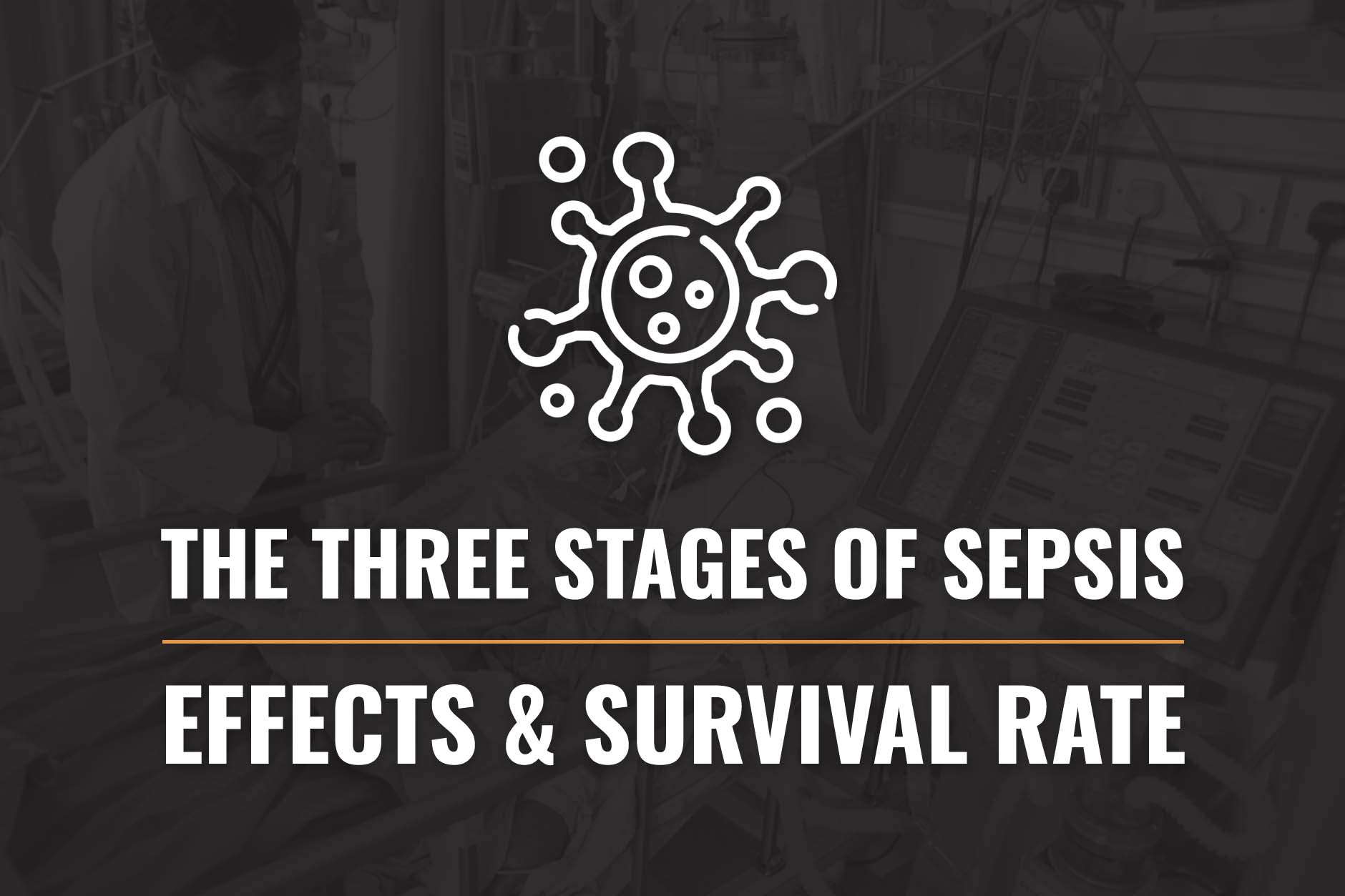
Table of Contents
Sepsis is a dangerous condition that occurs when your body’s response to an infection causes severe inflammation. This can lead to tissue damage, organ failure, and, in severe cases, death. Although sepsis can stem from any infection, including those resulting from minor injuries, its progression can be rapid and challenging to detect early.
If sepsis develops due to an injury caused by someone else’s negligence -whether in a car accident, workplace incident, or due to medical malpractice– there may be grounds to seek financial compensation. In this blog, we’ll explore the three stages of sepsis and go over the symptoms, effects, survival rates, and legal implications when it arises from preventable injuries.
Stage 1: Sepsis
The first stage, known as sepsis, begins when the body’s immune system responds aggressively to an infection. This response can be triggered by a variety of injuries, such as cuts, burns, or surgical wounds that become infected. While the body’s immune system is designed to combat these infections, the response can sometimes spiral out of control, leading to widespread inflammation.
Symptoms of Sepsis
- Fever or Hypothermia: As the body fights infection, a high fever is often one of the first signs of sepsis. However, in some cases, the body may instead experience hypothermia, where the temperature drops below normal, signaling a serious disruption in the body’s regulatory systems.
- Increased Heart Rate: When the body is infected, the heart pumps faster, trying to circulate blood more rapidly in order to combat the invaders. A heart rate of more than 90 beats per minute is common, even at rest.
- Rapid Breathing: The body’s demand for oxygen increases as it battles the infection, leading to rapid breathing, or tachypnea. This can start subtly but may progress to noticeable shortness of breath.
- Confusion or Disorientation: As sepsis progresses, the infection and resulting inflammation can affect the brain, leading to confusion, difficulty concentrating, or a sudden change in mental state. This symptom is particularly concerning in older adults, who may already be at risk for cognitive decline.
Effects of Sepsis
Without prompt treatment, sepsis can lead to a rapid decline in overall health. The widespread inflammation caused by the body’s immune response can disrupt normal blood flow, leading to clotting issues, dangerously low blood pressure, and eventually, organ dysfunction. The body’s organs may start to fail one by one as they are deprived of the oxygen and nutrients they need to function. This stage of sepsis is critical, and immediate medical intervention is necessary to prevent the condition from worsening.
Survival Rate
When sepsis is identified and treated early, the survival rate is relatively high, with many patients recovering fully after receiving antibiotics, fluids, and supportive care. However, if the condition is not recognized in time, or if treatment is delayed, sepsis can quickly escalate to more severe stages, where the survival rate drops significantly.
Sepsis can arise from situations like improper wound care, failure to diagnose an infection, or other forms of medical malpractice. If a healthcare provider’s negligence leads to an infection that progresses to sepsis, there may be grounds for a personal injury lawsuit. Accidents caused by negligence -such as car crashes, falls, or workplace injuries- can result in wounds that become septic.
Stage 2: Severe Sepsis
If the infection and resulting inflammation are not brought under control in the first stage, sepsis can progress to severe sepsis. During this stage, the body begins to show signs of widespread organ dysfunction as the inflammatory response spreads beyond the initial infection site.
Symptoms of Severe Sepsis
- Difficulty Breathing: As the lungs become affected by systemic inflammation, breathing can get increasingly difficult. Patients may experience shortness of breath, rapid breathing, or a feeling of being unable to get enough air. This occurs because the lungs are struggling to oxygenate the blood, which can lead to a dangerous drop in oxygen levels throughout the body.
- Decreased Urine Output: The kidneys, which are particularly sensitive to changes in blood flow and pressure, may start to fail as severe sepsis takes hold. A noticeable decrease in urine output is a red flag, indicating that the kidneys are no longer able to filter waste effectively, which can lead to the buildup of toxins in the blood.
- Abdominal Pain: The digestive system may also be affected by severe sepsis, leading to abdominal pain, nausea, vomiting, or even bowel obstructions. This pain is a sign that the organs in the abdomen, including the liver and intestines, are not receiving adequate blood flow, which can cause them to start shutting down.
- Altered Mental State: Confusion, anxiety, agitation, or a marked change in consciousness can occur as the brain is deprived of oxygen and nutrients. This is particularly dangerous, as it can lead to further complications if the patient is unable to communicate their symptoms or understand their surroundings.
Effects of Severe Sepsis
When a patient is suffering from severe sepsis, multiple organs begin to fail. The body’s immune response, which was initially aimed at fighting the infection, becomes so overwhelming that it starts to damage the very organs it is supposed to protect. The kidneys, liver, and lungs are often the first to be affected, but other organs, such as the heart and brain, can also begin to fail as the condition progresses.
Survival Rate
The survival rate for severe sepsis is significantly lower than for sepsis, with mortality rates ranging from 20% to 40%. The chances of survival depend heavily on how quickly the condition is recognized and treated, as well as the patient’s overall health and ability to withstand the stress of multiple organ failures. Advanced medical care, including the use of vasopressors to support blood pressure and mechanical ventilation for breathing, is often required to stabilize the patient.
Severe sepsis often results from delayed or inadequate treatment of initial sepsis. For example, if a healthcare provider fails to recognize the early signs of sepsis or does not administer appropriate treatment promptly, the condition may progress to severe sepsis. Victims and their families may be entitled to monetary compensation if negligence contributed to the development of severe sepsis.
Stage 3: Septic Shock
The third and most dangerous stage of sepsis is septic shock. At this stage, the body’s organs are in critical condition and the patient’s life is in imminent danger. Septic shock is characterized by a high drop in blood pressure that does not respond to fluid replacement, leading to insufficient blood flow to the organs.
Symptoms of Septic Shock
- Extremely Low Blood Pressure: One of the most defining features of septic shock is a drastic drop in blood pressure, known as hypotension. Despite aggressive fluid therapy, the blood pressure remains dangerously low, which severely compromises the delivery of oxygen and nutrients to vital organs.
- Multiple Organ Failure: Multiple organs can fail simultaneously due to septic shock, including the heart, lungs, kidneys, and liver. This is because the body is no longer able to sustain adequate blood flow, resulting in widespread tissue damage. The heart may struggle to pump blood effectively, the lungs may fail to oxygenate the blood, and the kidneys may stop filtering waste, all of which contribute to the rapid decline in health.
- Cool, Pale Extremities: Reduced blood flow can cause the skin, particularly in the extremities like the hands and feet, to become cool, pale, and clammy. This symptom is a sign that the body is prioritizing blood flow to essential organs, but it also indicates that the situation is becoming increasingly dire.
- Rapid Heart Rate and Breathing: The body is in a state of extreme distress, with the heart and lungs working overtime to compensate for the failing organs. The heart rate may skyrocket and breathing may become rapid and shallow as the body attempts to maintain life-sustaining functions.
Effects of Septic Shock
Septic shock is often fatal if not treated immediately. The combination of low blood pressure, poor blood flow, and multiple organ failures creates a dire situation that is difficult to reverse. Even with prompt treatment, the chances of full recovery are slim and many survivors experience long-term health issues, including permanent organ damage, chronic fatigue, and cognitive impairments.
Survival Rate
The survival rate for septic shock is alarmingly low, with mortality rates ranging from 40% to 60%. The earlier septic shock is identified and treated, the better the chances of survival, but the prognosis is still grim. Survivors often require lengthy hospital stays, including time in intensive care units, and may need ongoing medical support after discharge.
Septic shock is a clear indicator of severe medical issues that may have been preventable with proper care. If a healthcare provider’s negligence leads to septic shock -whether through failure to diagnose, delay in treatment, or improper management of an infection- legal action may be warranted. If septic shock results from injuries sustained in an accident caused by another’s negligence, such as a car accident or workplace injury, there may also be grounds for a personal injury claim.
Preventing Sepsis After an Injury
Preventing sepsis begins with proper wound care and prompt treatment of infections. Here are some key steps to help prevent sepsis from setting in after an injury:
- Clean and Dress Wounds Promptly: Proper hygiene and wound care are your first lines of defense against sepsis. Whether it’s a minor cut or a severe injury, cleaning the wound thoroughly and applying an appropriate dressing can prevent infection.
- Monitor for Signs of Infection: Redness, swelling, increased pain, and pus are all signs that a wound may be infected. If any of these symptoms occur, seek medical attention immediately to prevent the infection from spreading.
- Follow Prescribed Treatment: If a healthcare provider prescribes antibiotics or other treatments for an infection, follow the instructions precisely to prevent the infection from worsening. Misuse or incomplete use of antibiotics can lead to antibiotic resistance, making infections harder to treat.
- Attend Follow-Up Appointments: Regular check-ups after an injury can help catch any developing issues before they become serious. These appointments are crucial for monitoring the wound’s healing progress and addressing any concerns that may arise.
Examples of Cases Involving Sepsis
Sepsis can develop from a variety of injuries and medical situations, particularly when proper care is not administered. They include but may not be limited to the situations below.
Car Accidents
Victims of car accidents may suffer deep cuts, burns, or other injuries that become infected. If the accident was caused by another driver’s negligence, the victim may be entitled to compensation for the injuries and any resulting sepsis. In some cases, the trauma of the accident itself can lead to a compromised immune system, making the body more susceptible to infections that can lead to sepsis.
Workplace Injuries
Construction workers, factory workers, and others in hazardous jobs may suffer injuries that lead to infection and sepsis. If the injury was due to unsafe working conditions, lack of proper safety equipment, or employer negligence, there may be grounds for a claim. For example, a worker who suffers a deep laceration on the job and does not receive prompt medical care may develop an infection that progresses to sepsis.
Medical Malpractice
If a healthcare provider fails to properly treat a wound or diagnose an infection that leads to sepsis, the patient may have a medical malpractice claim. This is especially true if the sepsis progresses to severe sepsis or septic shock, resulting in significant harm or death. Cases of medical malpractice involving sepsis often focus on the failure to recognize early signs, delayed treatment, or inadequate care that allowed the infection to spread.
Speak to a Michigan Personal Injury Lawyer Today
Sepsis can develop rapidly and requires prompt medical attention to prevent severe health outcomes or death. If you or a loved one develop this condition after a preventable accident, it’s important to consult with a personal injury lawyer who can help you understand your rights and options. At LegalGenius PLLC, we have been a trusted advocate for injured clients for decades. We firmly believe that your health and well-being should never be compromised due to another’s carelessness, and will help you fight to hold the responsible parties accountable. To schedule your free consultation and case review, fill out our Ask the Genius™ form or call (800) 209-4000 today.

Attorney Jeffrey Perlman
Attorney Jeffrey Perlamn is the managing partner at LegalGenius, PLLC. He has helped Metro Detroit accident victims recover the compensation they deserve for over 35 years. He believes everyone should have access to justice and the legal system, which is why Attorney Perlman spends his time outside of the courtroom writing informational blogs on the LegalGenius website that are accessible to all.


